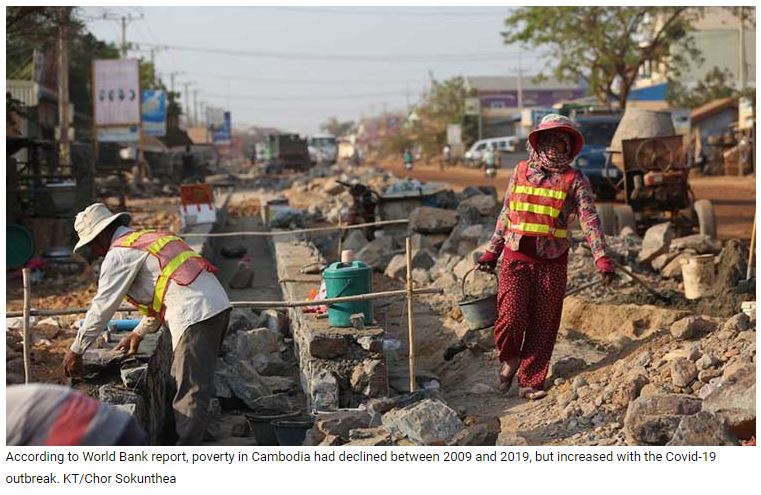‘Pandemic pushed 460,000 Cambodians back into poverty’
The poverty rate in Cambodia, which had declined by almost half between 2009 and 2019, increased again with the Covid-19 outbreak, says a World Bank report released yesterday.
Cambodia’s poverty declined from 33.8 percent to 17.8 percent in 10 years to 2019 with almost 2 million Cambodians coming out of poverty, says the World Bank’s Poverty Assessment Report for Cambodia, titled ‘Toward a More Inclusive and Resilient Cambodia’.
Since 2020, the rate has increased by 2.8 percentage points, indicating that around 460,000 people have fallen below the poverty income threshold.
Between 2009 and 2019, Cambodia experienced a decade of growth and widespread income gains. Rapid economic expansion, combined with structural change, led to rising wages and higher standards of living. Rising non-farm earnings, for example in the tourism, garment, and construction sectors, have contributed the most to poverty reduction, the report finds.
Similarly, trade and investment-led growth supported structural transformation toward more productive sectors, creating better-paying manufacturing and services jobs. Workers were able to move out of low-paying agriculture into better-paying sectors of the economy and boost their earnings.
At the same time, living conditions and access to basic services such as electricity, water supply, sanitation, health, and education improved for broad segments of the population. This improvement has narrowed standard-of-living gaps between rural and urban households.
“Efforts to accelerate Cambodia’s structural transformation have helped reduce poverty,” said Maryam Salim, World Bank Country Manager for Cambodia. “However, despite this impressive success, many households remained vulnerable, with few savings or safety nets. This meant Covid-19 dealt a setback to the country’s progress in combating poverty as employment and wages diminished.”
To support a more inclusive and resilient recovery from the pandemic and the economic shocks that came with it, Cambodia could consider a range of policy actions, the report suggested. These include targeted cash transfers, steps to strengthen social protection, and investments in health and education.
Hong Vannak, an economic researcher at the Royal Academy of Cambodia, told Khmer Times, the pandemic appeared to have exacerbated the situation across the world. Before the Covid-19 outbreak, the government had a number of policies for rehabilitation and development. They had been put in place to diversify and improve their efficiency in mobilising resources for public investment, especially education and health services.
“During the Covid-19 crisis, Cambodia continued to pursue policy plans, especially budget increases for SME Bank, the Agricultural and Rural Development Bank, and expansion of public spending on infrastructure in Sihanoukville, Kep, Kampot provinces. In addition, the government has spent a lot of money on people affected by the Covid-19 crisis,” Vannak said.
During the epidemic in 2021, the government spent money on vaccines and successfully vaccinated almost 100 percent of the population.
“The poverty rate of more than 2 percent is a concern that the Cambodian government does not ignore. Not only that, since opening up of the country by the end of 2021, the Cambodian government has restored and developed the economy through international cooperation, especially within the ASEAN framework and the global framework, in investing and promoting exports and creating jobs,” Vannak remarked.
Source: https://www.khmertimeskh.com/501192893/pandemic-pushed-460000-cambodians-back-into-poverty/


 English
English




